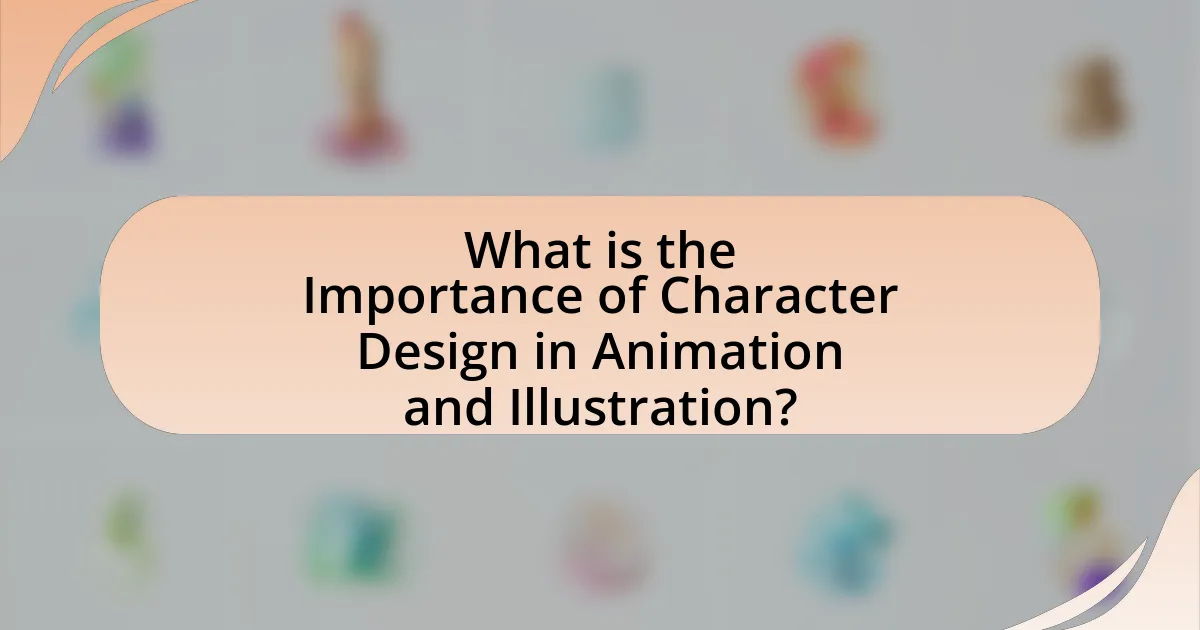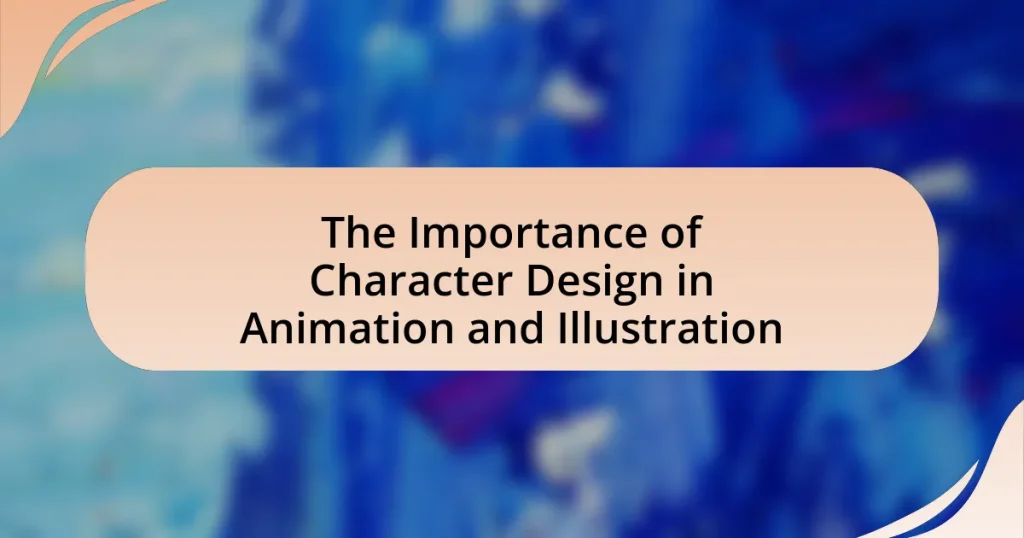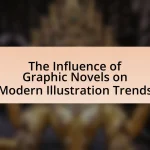Character design is a fundamental aspect of animation and illustration, playing a crucial role in establishing the visual identity and emotional connection of characters. This article explores the significance of character design in storytelling, audience engagement, and character development, highlighting how visual elements such as color, shape, and backstory influence viewer perception. It also examines historical developments in character design, the impact of animation styles, and best practices for creating relatable characters. Additionally, the article addresses common challenges designers face and discusses future trends and technological advancements shaping the field.

What is the Importance of Character Design in Animation and Illustration?
Character design is crucial in animation and illustration as it establishes the visual identity and personality of characters, influencing audience engagement and emotional connection. Well-designed characters can convey complex traits and narratives through visual cues, making them memorable and relatable. For instance, iconic characters like Mickey Mouse and SpongeBob SquarePants have distinct designs that resonate with audiences, enhancing storytelling and brand recognition. Research indicates that character design significantly impacts viewer perception and emotional response, underscoring its importance in creating compelling visual narratives.
Why is character design crucial for storytelling in animation?
Character design is crucial for storytelling in animation because it visually conveys the personality, emotions, and motivations of characters, which are essential for audience engagement. Effective character design allows viewers to quickly understand a character’s role and traits, facilitating emotional connections and enhancing narrative depth. For instance, the distinct visual styles of characters in Pixar films, such as the rounded shapes of “Toy Story” characters, evoke feelings of warmth and friendliness, directly influencing audience perception and emotional response. This alignment between character design and storytelling elements is supported by research indicating that visual cues significantly impact viewer interpretation and empathy, reinforcing the importance of character design in animated narratives.
How does character design influence audience connection?
Character design significantly influences audience connection by establishing emotional resonance and relatability. Well-crafted characters often embody traits that audiences can identify with, such as vulnerability, strength, or humor, which fosters empathy. For instance, a study published in the Journal of Visual Culture highlights that characters with distinct visual traits, such as exaggerated features or unique color palettes, can evoke specific emotional responses, enhancing viewer engagement. This connection is further reinforced through storytelling, where character design complements narrative arcs, making characters memorable and impactful.
What role does character design play in character development?
Character design plays a crucial role in character development by visually conveying personality traits, emotional depth, and narrative context. Effective character design utilizes elements such as color, shape, and detail to reflect a character’s background and motivations, thereby enhancing audience engagement and understanding. For instance, a character designed with sharp angles and dark colors may suggest a more aggressive or villainous nature, while softer shapes and lighter colors can indicate friendliness or innocence. This visual representation aids in storytelling by allowing viewers to quickly grasp the essence of a character, facilitating a deeper emotional connection and investment in their journey.
How does character design impact visual aesthetics?
Character design significantly impacts visual aesthetics by establishing the overall style and emotional tone of a visual narrative. The design elements, such as shape, color, and proportion, influence how characters are perceived and can evoke specific feelings in the audience. For instance, rounded shapes often convey friendliness, while sharp angles may suggest danger or aggression. Research by Paul Wells in “Understanding Animation” highlights that character design is crucial in creating a visual language that communicates personality traits and narrative roles, thereby enhancing the viewer’s emotional engagement and understanding of the story.
What elements contribute to effective character design?
Effective character design is influenced by several key elements, including silhouette, color palette, personality traits, and backstory. A strong silhouette ensures that a character is easily recognizable and memorable, while a well-chosen color palette can evoke specific emotions and convey personality. Additionally, defining personality traits helps to create relatable and engaging characters, and a compelling backstory adds depth and context, making the character more believable. These elements work together to create characters that resonate with audiences, as evidenced by successful animated films and illustrations that prioritize these design principles.
How do color and shape affect character perception?
Color and shape significantly influence character perception by evoking specific emotions and associations. For instance, warm colors like red and orange often convey energy or aggression, while cool colors like blue and green can suggest calmness or tranquility. Similarly, shapes play a crucial role; rounded shapes are typically perceived as friendly and approachable, whereas sharp angles may be associated with danger or hostility. Research by the University of California, Berkeley, indicates that color can affect mood and behavior, reinforcing the idea that visual elements in character design directly impact audience perception and emotional response.
What are the historical developments in character design?
Historical developments in character design include the evolution from simple, two-dimensional representations in early animation to complex, three-dimensional models in contemporary media. In the early 20th century, characters like Felix the Cat and Mickey Mouse were designed with exaggerated features to convey personality and emotion, reflecting the limitations of animation technology at the time. The introduction of synchronized sound in the 1920s further influenced character design, as animators began to create characters that could express sound through movement and facial expressions.
By the mid-20th century, the rise of television brought about iconic characters such as Bugs Bunny and Scooby-Doo, which were designed to appeal to specific demographics and cultural contexts. The 1990s saw the advent of computer-generated imagery (CGI), leading to characters like Woody and Buzz Lightyear from “Toy Story,” which showcased the potential for detailed textures and lifelike movements.
In recent years, character design has continued to evolve with advancements in technology, allowing for more diverse and inclusive representations in media. The development of software like Adobe Illustrator and Blender has enabled artists to create intricate designs that resonate with global audiences. This historical trajectory illustrates how character design has adapted to technological advancements and cultural shifts, emphasizing its critical role in animation and illustration.
How have animation styles influenced character design trends?
Animation styles have significantly influenced character design trends by dictating the visual aesthetics and emotional expressions of characters. For instance, the rise of Japanese anime introduced exaggerated facial features and dynamic poses, which have become staples in character design globally. Similarly, the minimalist approach of Western animation in the 2000s, exemplified by shows like “Adventure Time,” led to simpler shapes and vibrant color palettes in character designs. These shifts reflect broader cultural trends and technological advancements, such as the transition from hand-drawn to digital animation, which allows for more fluid and diverse character expressions. The impact of these animation styles is evident in the way contemporary character designs prioritize expressiveness and relatability, aligning with audience preferences for engaging storytelling.
What are some iconic examples of character design evolution?
Iconic examples of character design evolution include Mickey Mouse, Batman, and Lara Croft. Mickey Mouse, created by Walt Disney in 1928, has undergone significant changes from his original design, evolving from a simple black-and-white character to a more detailed and colorful figure, reflecting advancements in animation technology and changing audience preferences. Batman, introduced in 1939 by Bob Kane and Bill Finger, has seen various redesigns that emphasize different aspects of his persona, from the campy look of the 1960s television series to the darker, more realistic interpretations in modern comics and films, showcasing shifts in cultural attitudes towards heroism. Lara Croft, first appearing in the video game “Tomb Raider” in 1996, has evolved from a polygonal character with exaggerated features to a more realistic and relatable figure in recent games, reflecting changes in gaming technology and societal views on female protagonists. These examples illustrate how character design evolves in response to technological advancements and cultural shifts.
How does character design relate to audience engagement?
Character design significantly influences audience engagement by creating relatable and memorable figures that resonate emotionally with viewers. Engaging character designs often incorporate distinct visual traits, personality traits, and backstories that allow audiences to form connections, fostering empathy and investment in the narrative. For instance, research indicates that characters with unique designs and well-developed personalities can increase viewer retention and emotional responses, as seen in successful animated series like “Toy Story,” where characters like Woody and Buzz Lightyear are designed to evoke specific feelings and attachments. This connection enhances the overall viewing experience, making character design a crucial element in capturing and maintaining audience interest.
What techniques enhance character relatability in animation?
Techniques that enhance character relatability in animation include the use of expressive facial features, relatable backstories, and universal emotions. Expressive facial features allow audiences to connect with characters on an emotional level, as studies show that viewers respond to facial expressions that convey feelings such as joy, sadness, or anger. Relatable backstories provide context for a character’s motivations and struggles, making them more human and accessible; for instance, characters who face challenges similar to those of the audience can foster empathy. Additionally, incorporating universal emotions, such as love, fear, and hope, resonates across diverse audiences, as research indicates that shared emotional experiences can significantly increase viewer engagement and attachment to characters.
How can character backstories enrich design choices?
Character backstories can enrich design choices by providing context that informs visual elements, such as color schemes, clothing, and physical traits. For instance, a character with a troubled past may be designed with darker colors and rugged clothing to reflect their experiences, while a character with a joyful background might feature bright colors and playful attire. This alignment between backstory and design enhances audience connection and understanding, as viewers can infer personality traits and emotional states from visual cues. Research in character design emphasizes that cohesive storytelling through design leads to more engaging and relatable characters, ultimately improving the overall impact of animation and illustration.
What psychological principles can be applied to character design?
Psychological principles that can be applied to character design include the principles of Gestalt psychology, color psychology, and the theory of archetypes. Gestalt psychology emphasizes how individuals perceive whole forms rather than just the sum of parts, which can guide designers in creating cohesive and relatable characters. Color psychology indicates that different colors evoke specific emotions; for instance, blue can convey trust, while red can signify passion, influencing audience perception of characters. The theory of archetypes, as proposed by Carl Jung, suggests that certain character types resonate universally, such as the hero or the mentor, allowing designers to create characters that audiences can easily identify with and understand. These principles are validated by studies in psychology that demonstrate how visual elements and character traits impact viewer engagement and emotional response.
What are the best practices for effective character design?
Effective character design requires a clear understanding of the character’s personality, backstory, and role within the narrative. This foundational knowledge informs visual elements such as shape, color, and style, which should align with the character’s traits and the overall theme of the project. For instance, a villain may utilize sharp angles and dark colors to evoke fear, while a hero might feature rounded shapes and bright colors to convey warmth and approachability.
Additionally, consistency in design across various poses and expressions is crucial for maintaining character recognition and believability. Research indicates that characters with distinct silhouettes and memorable features enhance audience engagement and retention. A study by the University of Southern California found that characters with unique designs are more likely to be remembered by viewers, reinforcing the importance of originality in character creation.
In summary, effective character design hinges on a deep understanding of the character’s essence, visual coherence, and originality, all of which contribute to a compelling narrative experience.
How can designers balance originality and familiarity in character design?
Designers can balance originality and familiarity in character design by incorporating unique traits while adhering to recognizable archetypes. This approach allows for innovation within established frameworks, making characters relatable yet distinct. For instance, using familiar shapes or color palettes can evoke comfort, while introducing unconventional features or backstories can enhance originality. Research indicates that characters with a blend of familiar and novel elements are more engaging, as they resonate with audiences’ expectations while sparking curiosity. This balance is crucial in animation and illustration, where character design significantly impacts viewer connection and storytelling effectiveness.
What tools and software are recommended for character design?
Recommended tools and software for character design include Adobe Photoshop, Adobe Illustrator, Procreate, Clip Studio Paint, and Blender. Adobe Photoshop is widely used for its powerful painting and editing capabilities, making it ideal for creating detailed character illustrations. Adobe Illustrator is favored for vector-based designs, allowing for scalable artwork. Procreate is popular among digital artists for its intuitive interface and robust brush options on iPad. Clip Studio Paint is specifically designed for comic and manga artists, offering features tailored for character design. Blender is a leading 3D modeling software that enables the creation of detailed 3D character models and animations. These tools are recognized in the industry for their effectiveness in character design, as evidenced by their widespread adoption among professional artists and animators.
What common challenges do designers face in character design?
Designers face several common challenges in character design, including achieving originality, maintaining consistency, and balancing functionality with aesthetics. Originality is crucial as designers strive to create unique characters that stand out; however, the saturation of existing designs makes this difficult. Consistency is essential for ensuring that characters remain recognizable across various scenes and media, which can be challenging when adapting designs for different contexts. Additionally, designers must balance functionality, ensuring that characters can perform required actions, with aesthetics, which involves creating visually appealing designs that resonate with audiences. These challenges are well-documented in industry literature, highlighting the complexities involved in character design within animation and illustration.
How can designers overcome creative blocks in character design?
Designers can overcome creative blocks in character design by employing techniques such as brainstorming, seeking inspiration from various sources, and taking breaks to refresh their minds. Brainstorming allows designers to generate a multitude of ideas without judgment, which can lead to unexpected solutions. Research indicates that exposure to diverse stimuli, such as art, nature, or different cultures, can spark creativity and provide new perspectives. Additionally, taking breaks has been shown to enhance problem-solving abilities, as it allows the subconscious mind to process information and generate ideas more effectively.
What are the pitfalls to avoid in character design?
The main pitfalls to avoid in character design include lack of originality, inconsistent style, and neglecting character backstory. Lack of originality can lead to characters that feel generic and unmemorable, which diminishes audience engagement. Inconsistent style can confuse viewers and disrupt the visual narrative, making it difficult for them to connect with the character. Neglecting character backstory results in shallow characters that lack depth, making it hard for audiences to empathize with their motivations and actions. These pitfalls can significantly undermine the effectiveness of character design in animation and illustration, as evidenced by numerous critiques of popular media where characters failed to resonate due to these issues.
What are the future trends in character design for animation and illustration?
Future trends in character design for animation and illustration include increased use of diverse representation, integration of technology such as augmented reality (AR) and virtual reality (VR), and a focus on sustainability in design practices. Diverse representation is becoming essential as audiences demand characters that reflect a wide range of backgrounds and experiences, enhancing relatability and engagement. The integration of AR and VR technologies allows for more immersive character interactions, enabling designers to create dynamic and interactive experiences. Additionally, sustainability is gaining traction, with designers prioritizing eco-friendly materials and practices, aligning with global movements towards environmental responsibility. These trends are supported by industry shifts and audience preferences, indicating a clear direction for the future of character design.
How is technology shaping the future of character design?
Technology is significantly shaping the future of character design through advancements in 3D modeling, artificial intelligence, and virtual reality. These technologies enable artists to create more complex and realistic characters with greater efficiency. For instance, 3D modeling software like Blender and Maya allows for intricate designs and animations that were previously time-consuming and labor-intensive. Additionally, AI tools can assist in generating character concepts and automating repetitive tasks, thus streamlining the design process. Virtual reality platforms provide immersive environments for designers to visualize and interact with their characters in real-time, enhancing creativity and innovation. The integration of these technologies not only improves the quality of character design but also expands the possibilities for storytelling in animation and illustration.
What emerging styles are influencing character design today?
Emerging styles influencing character design today include 3D stylization, minimalism, and retro aesthetics. 3D stylization has gained traction due to advancements in technology, allowing for more dynamic and visually appealing characters, as seen in popular animated films like “Spider-Man: Into the Spider-Verse.” Minimalism emphasizes simplicity and clean lines, which can be observed in various mobile games and animations, making characters easily recognizable and appealing. Retro aesthetics draw inspiration from 80s and 90s animation, creating a nostalgic appeal that resonates with audiences, as evidenced by the resurgence of pixel art in indie games. These styles reflect current trends in technology and audience preferences, shaping the future of character design.
What practical tips can improve character design skills?
To improve character design skills, practice sketching regularly to develop a strong understanding of anatomy and proportions. Regular sketching helps artists internalize the structure of the human body and the way it moves, which is essential for creating believable characters. Additionally, studying various art styles and analyzing successful character designs from different media can provide insights into effective design choices. Research shows that artists who engage in diverse visual studies enhance their creative flexibility and problem-solving abilities in design. Furthermore, seeking feedback from peers and mentors can lead to constructive criticism, allowing designers to refine their work and identify areas for improvement.


